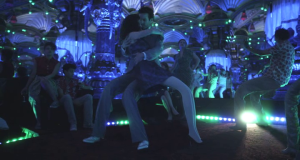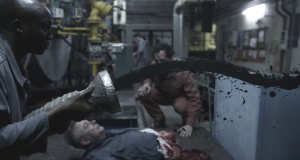 Mood Indigo (Michel Gondry, France, 2013, 131 minutes)
Mood Indigo (Michel Gondry, France, 2013, 131 minutes)
WUD Mini-Indie Film Festival, Union South Marquee Theater, Friday, April 25, 9:15pm»
There is more visual inventiveness in any five minutes of Michel Gondry’s Mood Indigo than you’ll find in many of the films in the minimalist wing of this year’s Wisconsin Film Festival put together. Along with Wes Anderson, Gondry has become one of the most interesting visual stylists working today. But unlike Anderson, Gondry has not always been able to use his entire palette in his feature films (especially his more conventional projects like The Green Hornet and Be Kind, Rewind). Even in his more personal projects, however, Gondry has not always found the right balance between narrative and spectacle. With Charlie Kaufman’s script for Eternal Sunshine of the Spotless Mind, Gondry found that balance; with his own script for The Science of Sleep, not so much. With Mood Indigo, Gondry delivers his strongest feature film since Eternal Sunshine (I need to catch up with a few to be certain, but I’m pretty confident in the claim). Despite a narrative that doesn’t seem to go much beneath the surface of a traditional romance for the first hour, by the end his ever decaying mise-en-scene vividly conveys a dream-like dystopia in which the characters seem oblivious or indifferent to their own deterioration, addiction, and suffering.
 On the surface, then, we have a romance between Colin (Romain Duris) and Chloe (played by everyone’s favorite gamine, Audrey Tatou). Their meet-cute is at a party where they dance the “biglemoi” to Duke Ellington (you’ll have to learn how to elongate and curve your legs before you try this at your next dance party). Colin is independently wealthy (somehow) and has a servant/chef/lawyer/friend Nicolas (Omar Sy) who lives with him in a nearly-magical apartment where Colin spends his time inventing devices like the “Pianocktail,” which mixes the perfect cocktail based on what you play on the piano keys. Nicolas’s cousin, Isis, strikes up a romance with Colin’s best friend Chick, an intellectual who seems to be addicted to the work of philosopher Jean-Sol Partre (get it?). The first hour of Mood Indigo is brimming with visual ideas and gags as the young couples explore Paris and Colin and Chloe’s romance eventually leads to a wild wedding ceremony: Colin and Chloe must race Chick and Isis in go-carts to the altar, and the couple that gets there first will get married.
On the surface, then, we have a romance between Colin (Romain Duris) and Chloe (played by everyone’s favorite gamine, Audrey Tatou). Their meet-cute is at a party where they dance the “biglemoi” to Duke Ellington (you’ll have to learn how to elongate and curve your legs before you try this at your next dance party). Colin is independently wealthy (somehow) and has a servant/chef/lawyer/friend Nicolas (Omar Sy) who lives with him in a nearly-magical apartment where Colin spends his time inventing devices like the “Pianocktail,” which mixes the perfect cocktail based on what you play on the piano keys. Nicolas’s cousin, Isis, strikes up a romance with Colin’s best friend Chick, an intellectual who seems to be addicted to the work of philosopher Jean-Sol Partre (get it?). The first hour of Mood Indigo is brimming with visual ideas and gags as the young couples explore Paris and Colin and Chloe’s romance eventually leads to a wild wedding ceremony: Colin and Chloe must race Chick and Isis in go-carts to the altar, and the couple that gets there first will get married.
 Things get complicated after the honeymoon, however, when Chloe discovers that she has a water lily growing in her lung. Everything in the mise-en-scene starts to deteriorate, beginning with a web-like grime that encases Colin’s previously marvelous apartment. Even Nicolas begins to age quickly and prematurely. What I found interesting about the second half of the film is that Gondry remains visually playful even as the tone gets darker and more severe. While the film does not go much below the surface level, staying on the surface allows Gondry to get away with some pretty striking images which combine the playful glee of the first half with a pretty dark dystopia. Chick’s addiction to Parte leads him to cause a horrific accident at his factory job. I won’t go so far as to say this is played for laughs, but it reminds one of the tone of films like Terry Gilliam’s Brazil, where the pleasure of visual flamboyance is juxtaposed with some pretty oppressive material. There seemed to be at least a few tips of the hat to William Klein’s Mr. Freedom buried in there, too.
Things get complicated after the honeymoon, however, when Chloe discovers that she has a water lily growing in her lung. Everything in the mise-en-scene starts to deteriorate, beginning with a web-like grime that encases Colin’s previously marvelous apartment. Even Nicolas begins to age quickly and prematurely. What I found interesting about the second half of the film is that Gondry remains visually playful even as the tone gets darker and more severe. While the film does not go much below the surface level, staying on the surface allows Gondry to get away with some pretty striking images which combine the playful glee of the first half with a pretty dark dystopia. Chick’s addiction to Parte leads him to cause a horrific accident at his factory job. I won’t go so far as to say this is played for laughs, but it reminds one of the tone of films like Terry Gilliam’s Brazil, where the pleasure of visual flamboyance is juxtaposed with some pretty oppressive material. There seemed to be at least a few tips of the hat to William Klein’s Mr. Freedom buried in there, too.
Without any background on the film, it seemed to me like a flowing series of ideas and free associations, but I was surprised to find that many of the key plot elements (including the absurd ones like Chloe’s water lily and the satirical ones like Jean-Sol Parte) come directly from the original novel, L’Écume des jours, written by Boris Vian in 1947. The novel clearly provided Gondry with a fertile ground for his visual ideas, and without being dependent on his own narrative material (like in Science of Sleep) Gondry is able to flourish here. Mood Indigo is no where nearly as emotionally satisfying as Eternal Sunshine, nor does it try to be. Instead it transforms from a playful happy romance to a dark dystopia without removing the playful tone. The visual inventiveness continues to the very last frame, even as the color is literally removed from Colin’s world.
While you don’t necessarily identify closely with the characters and their plight, you do have an interesting emotional reaction as you continue to enjoy the visual playfulness as the tone becomes more bleak. So while Gondry is drawing from the bag of tricks we might expect from his music videos, the effect is more complicated than what can be achieved in the short form. Because of that, Mood Indigo might be a more successful realization of Gondry’s unique vision, even though I might personally prefer the more well rounded Eternal Sunshine.
Because of the vivid visuals and the mix of tones, I recommend seeing this with a crowd at the WUD Film Mini-Indie Festival on Friday. It should be interesting to feel the shift in tone with the crowd, if they are willing to go where the film takes them. Unfortunately, I will not be able to make the Union South Marquee Screening, so please chime in with your observations and responses in the comments below.